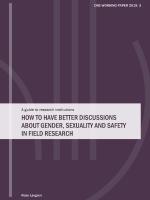DIIS Working Paper
Gender, sex and safety in field research
Pointers for universities in handling preparation and response to unsafe situations
When researchers from various disciplines do immersed field research, there is often a need to confront questions about gendered and sexualized safety. Reports from field researchers from around the world show that unsafe situations in the form of sexual harassment, assault and violence are recurring, especially for female and LGBTQ researchers. This working paper draws on the lessons from the literature together with the author’s own experiences to present four lines of advice for research institutions on how to improve the ways these issues are handled in academia:
- Safety in ‘the field’ starts ‘at home’. Research institutions need to work harder on their own climates of sexual safety.
- Gender and sexuality is everyone’s issue. These questions are often treated as women’s issues, but taking them seriously entails institution wide engagements with them.
- Not only ‘stranger danger’. Field research preparation activities often focus on the dangers of unknown assailants, and universities need to put more effort into preparing for and responding to other forms of gendered and sexualized unsafety.
- Gender, sexuality and safety are moving targets. Relations change during the course of field research, and safety is therefore best promoted through follow-up and responsive measures.
Please contact Robin May Schott, Senior Researcher at DIIS,if you have any questions to this Working Paper.
Topics

How to have better discussions about gender, sexuality and safety in field research
A guide to research institutions
